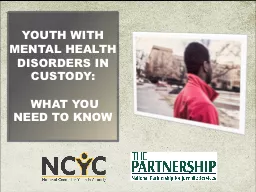

What you need to know Rome wasnt built in a day A journey is not a destination this is all good information but what do you want me to do differently Behavior is best understood and managed in context ID: 640516
Download Presentation The PPT/PDF document "Youth with Mental Health Disorders in cu..." is the property of its rightful owner. Permission is granted to download and print the materials on this web site for personal, non-commercial use only, and to display it on your personal computer provided you do not modify the materials and that you retain all copyright notices contained in the materials. By downloading content from our website, you accept the terms of this agreement.
Slide1
Youth with Mental Health Disorders in custody:
What you need to knowSlide2
“Rome wasn’t built in a day.”
“A journey is not a destination.”“..…this is all good information but what do you want me to do differently?”Behavior is best understood and managed in “context”Slide3
Participants will be able to:Better understand youth in custody with mental health disorders & identify
effective strategies to use when working with themDescribe the essential elements of a Juvenile Corrections Approach, a Treatment- O
riented Approach & Trauma-Responsive Approach as they relate to the effective care of youth in custody.Identify potential ways staff mental health can by impacted by working in a juvenile justice facility and some potential ways to minimize the effect on their personal and professional
livesSlide4
AgendaIntroduction, Prevalence, DefinitionsMental
Health Screening & AssessmentCommon Mental Health Disorders Among Youth in CustodyTrauma
Among Youth in Custody Head Injury Among Youth in Custody3 Approaches to Working with Youth in Custody w/ MentalHealth Disorders
Effective Strategies for Youth in Custody w/ Mental Health Disorders
Your Mental Health
Slide5
63-92% of youth in Juvenile Confinement settings meet criteria for Mental Health or Substance Use DisorderSlide6
“
A mental health disorder is a condition that impacts an individual’s thoughts, feelings or behavior (or a combination of all three) and that causes the individual significant distress or difficulty in functioning.”
(National Institute of Mental Health)Slide7
Common MENTAL HEALTH Disorders
Mood
Disorders (e.g
, Depression, Bipolar)
Attention-Deficit/Hyperactivity Disorder Conduct
Disorder
Substance
Use Disorders
Posttraumatic
Stress
Disorder
Anxiety Disorders
Learning Disorders
Intellectual
Disability
TEPLIN, et al 2002Slide8
Co-morbiditySuffering from more than one M
ental Health Disorder at the same time
Co-Occurring
Suffering from one or more Mental
H
ealth
D
isorders AND one or more Substance Use Disorders at the same timeSlide9Slide10
Mental Health ScreeningSlide11
Mental Health AssessmentSlide12
Mental health DisordersSlide13
1) What trauma they experienced 2) What behaviors you recognize from the video 3) How will you use today‘s information with him/her and othersSlide14
Head Injury/Brain TraumaSlide15
Studies show that 1 in 4 to almost 1 in 5 incarcerated youth suffer from traumatic brain injury Most are un-identified
(
Craswell et al 2004, Perron and Howard 2008)Slide16
Difficulty…..Planning ahead Accurately judging situationsControlling their emotionsPrioritizing
what’s importantControlling their behavior
Mental Health Chapter—Desktop Guide to Quality Practice for Working with Youth in Confinement (Boesky, 2014)Slide17
Therefore…..Following rules or directivesDelaying immediate
gratificationBehaving appropriatelyRegulating their emotionsLearning from consequences or past mistakes
Mental Health Chapter—Desktop Guide to Quality Practice for Working with Youth in Confinement (Boesky, 2014)Slide18
Juvenile Corrections
Trauma-
ResponsiveThree Approaches
Juveniles in Confinement
Treatment- OrientedSlide19
Juvenile CorrectionsSlide20
Treatment- OrientedSlide21
Trauma-
ResponsiveSlide22
Effective Management Strategies and Treatment Interventions for Youth in Custody with
Mental Health DisordersSlide23
BasicsProvide safetyProvide structure, c
onsistency, predictability Adequate staffing Treat youth as individualsClear understandable rulesHome-like environmentWelcoming/transparentSlide24
ALL Youth with Mental Health DisordersProvide praise Assist in problem-solving
Allow youth to ask clarifying questionsBe professional, helpful and validatingTeach youth calming skillsOffer alternate ways of thinking in response to thinking errorsSlide25
All Youth with Mental Health Disorders (2)Provide prompts/reminders
Provide clear limits and behavioral expectationsTeach and reinforce skillsProvide reinforcement and consequences ASAP Notify youth of any negative consequences Support youth during times of stress and transitionSlide26
Giving sanctions, or threatening to do so, does little to change the behavior of youth who have difficulty understanding abstract and future events or consequences. Slide27
All Youth with Mental Health Disorders (3)Reasonable expectations
Provide substance abuse treatment as neededInterventions that focus on anger, stress, thinking, social skills Listen,
support, de-escalate Exhibit patience, creativity, flexibility
Teach and coach practical coping skillsSlide28
Formal Mental Health Treatment• Ongoing, long-term, relapse•
CBT--appropriate level• Protective factors • Individualized plans, goals • Co-occurring, integrated, equal• Psychotropic medication• Modified anonymous
groupsSlide29
WHO ME?No energy/always tired
CynicalFeeling disconnected or isolated from othersHeadaches, stomachaches, pain, or illness
RestlessWorried, tense, or on-edgeFeeling trapped or overwhelmedNumbIrritable or short fuse
Upset stomach or nausea
Difficulty
managing emotions
Repeatedly making poor decisionsSlide30
WHO ME?Not caring about anything or anyone
Sudden feeling that something bad is going to happenTrouble falling or staying asleep/NightmaresDifficulty concentratingFinding
it difficult to get up in the morning Sweaty or damp and clammy handsLack of emotional responseFeeling hopelessNot enjoying things you used to enjoySlide31
T
he process of change that happens because you care about other people who have been hurt, and feel committed or responsible to help them.
Over time this process can lead to changes in your psychological, physical, and spiritual well-being.
-
Headington
Institute
Vicarious TraumaSlide32
For More Information…….Mental Health” Chapter--Desktop Guide to Quality Practice for Working with Youth in Confinement www.desktopguide.infoJuvenile Offenders With Mental Health Disorders: Who Are They & What Do We Do With Them (2nd Edition
) www.aca.org or Amazon.comAdditional NCYC/NPJS Training“Suicide Prevention Among Youth in Custody
: What You Need to Know” &“Behavior Management of Youth in Custody”